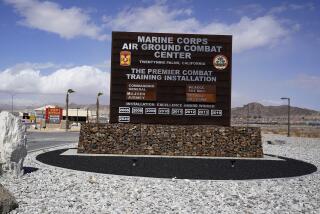A Blood and (Plastic) Guts Drill in El Toro : ‘Disaster’ Involves 80 at Marine Base
The huge cargo plane stopped in its tracks on a runway at the El Toro Marine Corps Air Station Thursday morning, with gray smoke billowing from its right wheel well. Moments later, two airmen were dragged off, looking bloody and badly injured.
Sirens sounded in the distance. Four massive, olive-colored trucks, spewing chemical fire-fighting foam, raced up and quickly discharged a swarm of silver-suited firemen.
But none of it was real.
The terrorist’s bomb that ripped apart the plane’s No. 3 engine, the gruesome injuries, the aborted takeoff: all were fake.
Most Extensive Drill
It was all part of the base’s most extensive drill in the past year, military officials said Thursday, involving an estimated 80 emergency-response people ranging from the base Crash/Fire/Rescue Team to air traffic controllers and public information officers.
The drill took place about 100 yards from the site of the base chapel that was destroyed when a plane crashed during the base’s annual air show in 1985, killing its pilot and passenger.
“The fellows from crash crew and station operations thought it would be a prudent thing to have one of these (drills) before the upcoming show,” Maj. Hank Polacke said. The next air show is scheduled for the weekend of June 6.
The rescue workers passed their test with flying colors Thursday, amid scenes that were sometimes grim, if not entirely serious.
Before rescue workers raced to the scene of the “aircraft mishap drill,” plastic intestines had been strapped to the bodies of the wounded. One Marine, who helped drag the first casualties to safety, ran back to the plane to grab a half-gallon Karo-syrup bottle and proceeded to pour “blood” over the wounds with the deftness of a makeup man who had plied his craft on the sets of “Nightmare on Elm Street.”
‘Just Unconscious’
“I’m the pilot,” said Capt. Ed Davis, smiling and extending his hand for a shake. “Two of my crew members were killed. I’m not injured, though. Just unconscious.”
So it went for more than an hour. When the emergency medical crews arrived to set up a triage area and mobile morgue, one flight surgeon practiced his bedside manner by tweaking a casualty playfully on the chin.
“Are you dead?,” he asked the body, whose face was covered with a plastic mask simulating first-degree burns. “You sure are ugly.”
And the dead rose like Lazarus to tell their stories. Capt. Joe Kelenfy, Davis’ co-pilot in the KC-130 cargo plane, walked up carrying a blue placard marked “DEAD.”
“We had an explosion in the engine, but reports are kind of sketchy now,” Kelenfy said.
During a subsequent debriefing, Lt. Col. Rick Scivique outlined the lessons learned during the hour-long drill and thanked the participants for the “vim and vigor” they brought to their task: “I especially want to thank the ‘victims,’ ” Scivique said. “You did a great job.”
More to Read
Sign up for Essential California
The most important California stories and recommendations in your inbox every morning.
You may occasionally receive promotional content from the Los Angeles Times.











